3D Measurements of Apollo 14 Landing Site
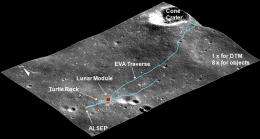
(PhysOrg.com) -- Can we measure the size and shape of equipment and other objects on the moon using orbital images from the current Lunar Reconnaissance Orbiter mission?
As an example, to demonstrate the precise 3D measurement capability of the LROC instrument's stereo imagery, three objects and the astronauts' footpaths at the Apollo 14 landing site are measured and their 3D models reconstructed.
Using two high-resolution images taken from two separate LRO orbits (1,943 and 1,596) by one of LROC's cameras, we can form a stereo image pair for 3D measurements at the Apollo 14 landing site. Thanks to the high image resolution of the LROC NAC cameras, among the visible objects are the descent stage of the Apollo 14 lunar module Antares, the ALSEP (Apollo Lunar Surface Experiments Package, and a formation nicknamed "Turtle Rock".
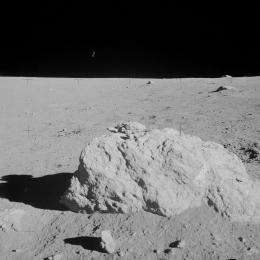
Also visible are multiple astronaut footpaths, clearly indicated by disturbed soils. Data processing methods can be used to identify the objects, as well as measure their sizes and shapes. Such information can then be used to reconstruct 3D models, which are displayed on the digital terrain model (DTM) of the site that is automatically generated from the same data set. The above image also shows Cone Crater at the northeast end of the astronaut traverse.
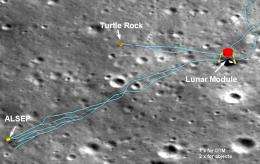
In the zoomed image below, the lunar module can be identified by its deck (red points) and distinctive shadow (green lines). These points are measured in the two stereo images and their corresponding 3D ground coordinates are computed. Note that the shadow analysis uses different times and sun angles of the two images for computation. In addition, the nearby terrain is measured at the selected points on the ground (green points) as a reference. From these measurements, we can compute the height and diameter of the lunar module. As the result, the height of the lunar module (descent stage) is estimated as 3.0 meters (about 9.8 feet), compared to the design specification of 3.2 meters (about 10.5 feet). On the other hand, the shadow analysis resulted in a height of the lunar module of 3.2 meters (about 10.5 feet). The diameter of the lunar module is computed as 4.4 meters (about 14.4 feet), compared to the design data of 4.2 meters (13.7 feet).
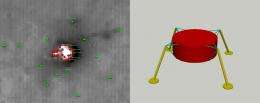
ALSEP and Turtle Rock are relatively short objects. The LROC NAC image resolution and the imaging geometry is not able to measure a height less than 1 meter (about 3 feet, 4 inches). However, we can measure their horizontal dimensions: 2 meters by 1 meter (about 6.6 by 3.3 feet) for ALSEP (yellow points, below left), and 1.5 meters by 1 meter (about 4.9 feet by 3.3 feet) for Turtle Rock (green points, below right).
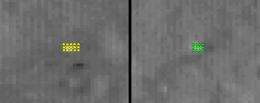
Provided by JPL/NASA




















